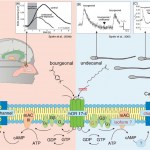A fascinating press release I want to pass along. At first I thought it was maybe good news in that rising sea levels would slow glacier drainage into the oceans but the affect is the opposite:
For the first time, researchers have closely observed how the ocean's tides can speed up or slow down the speed of glacial movement in Antarctica. The new data will help modelers better predict how glaciers will respond to rising sea levels.
Caltech's Brent Minchew (PhD '16) and Mark Simons, along with their collaborators and in cooperation with the Italian Space Agency (ASI), exploited four…
papers
Jeff Masters reports on these studies:
Grinsted, A., J. C. Moore, and S. Jevrejeva, 2012, "A homogeneous record of Atlantic hurricane surge threat since 1923," PNAS 2012, doi:10.1073/pnas.1209542109
Grinsted, A., J. C. Moore, and S. Jevrejeva, 2012, "Projected Atlantic hurricane surge threat from rising temperatures" PNAS March 18, 2013 201209980, doi: 10.1073/pnas.1209980110
There is a press release here.
And apparently this is on top of the effects from sea level rise, of which rises measured by metres are not out of the question. I believe that a 1 cm rise in sea level…
(image info and credits)
Fake skeptics of anthropogenic global warming love to set up the straw man that mainstream climate science believes that CO2 is the one and only driver of climate change. They can then use it in many different attacks, such as gee whiz isn't it stupid that they haven't even thought of the sun's influence. This is of course patently false as even the most cursory survey of actual scientific content will quickly reveal. This straw man is also an implicit part of the argument that the "16 year pause" in global warming proves that CO2 is not a climate…
Real Climate has done two posts recently that I thought would be served well by their juxtaposition. The first one highlights an early projection of global mean temperatures made by Jim Hansen in 1981.
The abstract for that paper contains this choice quote:
It is shown that the anthropogenic carbon dioxide warming should emerge from the noise level of natural climate variability by the end of the century, and there is a high probability of warming in the 1980's.
These are both things that have in fact happened. I think it is safe to call this a very successful early prediction of…
This morning, I learned that congress wants to reverse the advances made by NIH and go back to restricting access to scientific publications. Congresswoman Carolyn Maloney (New York) and Congressman Darrell Issa (California) are co-sponsoring a bill to restore the limits on public access to NIH-funded research.
I've written many times before (here, here, here, and here) about the challenges that community college faculty and students have in getting access to scientific papers.
In an era where the economic benefits of educating students in science are well-known (1), the idea of crippling…
No, this is not Steve McIntyre finally coming out with his own multi-century proxy temperature reconstruction. Nor is it Anthony Watt's release of his surfacestations.org temperature reanalysis.
It is the take away figure from a recent paper in Nature by Kinnard et al that reconstructs the extent of arctic sea ice over the last 1450 years.
Tamino has a discussion of it here.
There is not really much to add to the thousand words that image conveys.
As most of AFTIC readers will know by now, the Berkley Earth Surface Temprature project has pre-released its set of four studies that are still pending peer-review and publication. Bombshell news: the earth has warmed pretty much exactly as all the other analyses have indicated. UHI and micrositing issues do not explain away the measurements.
I don't have much to add to the dialogue, but here is a good place for locals to discuss and share links.
Watch the cllimate evolve here:
Update: here are a few relevant links:
Primary sources are here
The Economist gets there first
Muller has an op…
Did you ever wonder just how it can be possible that the same, thousand times debunked, climate "skepticisms" keep re-emerging, month after month, year after year? Obviously, there are those individuals (like Singer and Soon), organizations (like HeartlessLand), and media outlets (like Faux News) who deliberately lie and misinform with no concern for scientific or journalistic ethics whatsoever, but how is it they are so successful?
Well, it seems simple human nature, of the sort the most earnest and conscientious of us all possess, lends itself to being deceived by whomever yells loudest,…
I have been remiss in not bringing this excellent resource to the attention of AFTIC readers earlier. From the invaluable Skeptical Science website comes a brilliant interactive history of climate science.
Any comments on the choices for classification? I think it over counts skeptic and neutral papers.
It's not every day that you read about measuring skulls in the contemporary scientific literature. It's kind of a quaintly old-timey, quaintly racist kind of thing to do. But here we are, with a brand new paper about skull measuring in PLoS Biology. Already quite a few blog-words have been written in support of this new paper, which disproves Stephen Jay Gould's assertion in The Mismeasure of Man that George Morton's 1839 skull measurements were fudged intentionally or unintentionally by his racist bias.
I haven't read a lot of Gould, and I'm pretty convinced by the numbers in the paper…
Symbiosis is everywhere. From the Greek for "living with," symbiosis is simply a close association between two different species in nature. These relationships can be mutualistic, parasitic, or somewhere in between. Bacterial symbionts live inside bodies, like the bacteria that help us and other animals digest our food, and they live inside cells, like the bacteria that live in plant roots and provide their hosts with nitrogen. They can be metabolic, hygienic, or photosynthetic; ectosymbiotic, on the host surface, or endosymbiotic, inside the host's cells. Back in the 1860's biologists…
Cells permanently change their behavior in response to temporary changes to the environment, a kind of biological memory that controls processes as important and complex as how stem cells differentiate into specific tissues or how the immune system "remembers" dangerous pathogens. At its simplest, cellular memory is achieved with a positive feedback loop--once activated by some external signal, the feedback loop will continually activate itself, even as the cell divides and the signal is taken away. In synthetic biology we can recreate such simple feedback loops, genetic circuits built of…
One organism's trash is another organism's treasure. Our cellular wastes, carbon dioxide and water, nourish plants, which with added energy from sunlight produce the oxygen and sugars that we need to survive. At microscopic scales, these cycles of waste and food can get much more complicated, with many species of microbes working together to survive in harsh environments with limited nutrients.
When organisms (like us) digest sugars made of carbon (C), hydrogen (H), and oxygen (O), they split them up into carbon dioxide (CO2), hydrogen ions (H+) and high-energy electrons (e-) that were…
Over on the history of CO2 thread, that old chestnut of an issue has been raised, namely that there's this one paper in one journal, notorious for publishing anti-science papers on climate (a field well outside its focus), that has shown wild flucuations in CO2 to levels well above today's in times as recent as 60 years ago. Therefore....Not the IPCC.
The paper is by Ernst G Beck and the journal is Energy and Environment, 2009 (sorry, all my primary links are stale...anyone?)
Here is the graph, supposedly showing global CO2 levels:
This picture is at-a-glance completely implausible.
To…
Evolution connects all living things on earth, from the arsenic tolerant bacteria in the news this week to the human scientists and bloggers chatting about it. Eyes are intricately complex structures made up of many many cells, but even single-celled microbes can sense and respond to light through the function of proteins that share evolutionary similarity with the light receptors of the human retina. Incredibly, genetic engineering is showing us just how similar these proteins can be--transferring the genes that code for these processes leads to functional proteins, even when huge…
Real science is about the gathering of multiple lines of evidence, bulding on previous research that built on research before that. One of the hallmarks of denialism is choosing a single study or dataset out of a multitude simply because it is an outlier that confirms their prefered viewpoint.
On the "It's the sun, stupid" thread, mandas has provided a very nice listing of some of the many different examinations of solar forcing on recent climate change.
As with all robust scientific findings, the methods and datasets are different but the general conclusions are all the same: solar forcing…
Mammalian cells need something to hold on to before they can stick to each other and form tissues. The plastic dishes that cells grow on in the lab need to be first coated with special chemicals that grab the cells and convince them to stick. Once the first batch of cells is down they start forming their own matrix of proteins and fibers that can grab new cells as they are formed, slowly creating a dense layer of cells. Tissue engineering aims to make three dimensional, biodegradable scaffolds that cultured cells can grow on to form body parts, like the ear-shaped bit of cow cartilage that…
There was some big news yesterday in transgenic silk from Notre Dame and the University of Wyoming, where scientists have genetically engineered silkworms to produce silk that is a mixture of spider silk and the regular silkworm stuff. Silkworms produce the strong and versatile silk that is used to make clothes, but spiders produce silk that can be much stronger and much more elastic. Spiders, however, don't like to be grown in huge factories and don't make easily harvested cocoons like silkworms, so gathering even small amounts is very difficult (here's a fun how-to for collecting spider…
So I was browsing the internet for info on G-protein coupled receptors and ended up finding some interesting facts about sperm. It turns out sperm don't just swim blindly, hoping to randomly bump into eggs. Instead, like bacteria, sperm can sense their chemical environment and adjust their swimming accordingly. Sperm have a sense of smell.
The (g-protein coupled) olfactory receptors in our noses that activate our sense of smell were discovered in 1991, an amazing discovery that earned the 2004 Nobel prize for physiology or medicine. The receptors sit on the surface of the cells up high in our…
My good friend and labmate just published an awesome paper: "Emergent cooperation in microbial metabolism." His experiment started with 46 strains of E. coli that had mutations in their metabolic pathways that prevented them from being able to grow without supplementing the media with extra metabolites. Alone they died, but grown together in the same tube, many pairs of mutants were able to feed each other the missing metabolite. Metabolic cooperation was the key to survival.
Measuring and understanding metabolic cooperation can be used to build stronger, more predictive models of…












